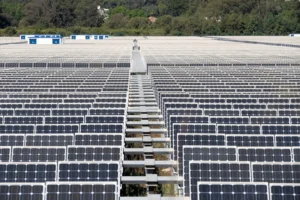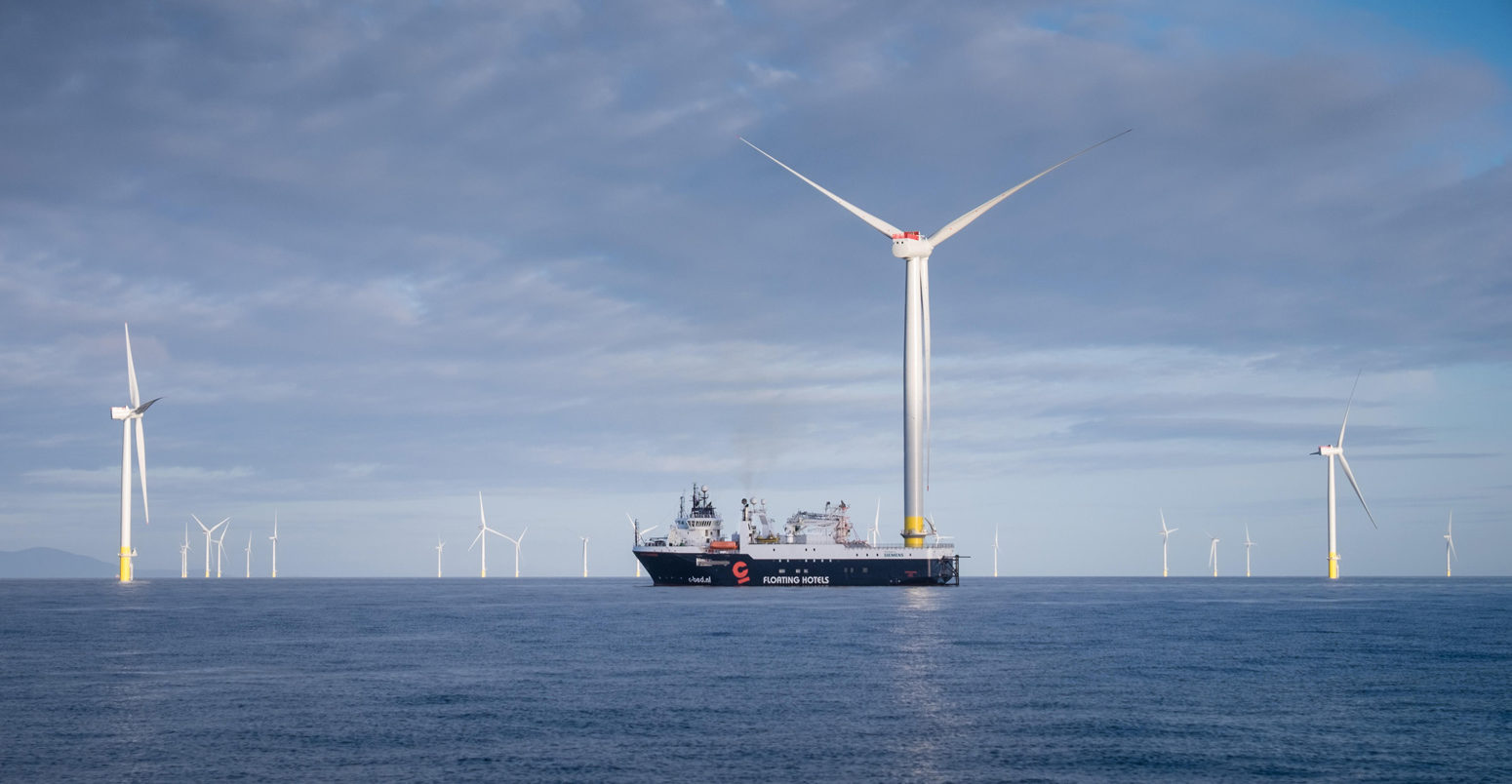
Analysis: Record-low price for UK offshore wind is nine times cheaper than gas
Simon Evans
07.08.22Simon Evans
08.07.2022 | 2:44pmA UK government auction has secured a record 11 gigawatts (GW) of new renewable energy capacity that will generate electricity nine times more cheaply than current gas prices.
The projects are all due to start operating within the next five years up to 2026/27 and have agreed to generate electricity for an average price of £48 per megawatt hour (MWh) in today’s money. This is nine times cheaper than the £446/MWh current cost of running gas-fired power stations.
(Update 24/08/2022: The article was updated with the latest power prices, which have risen significantly.)
Most of the new capacity – some 7GW – will be offshore wind. Notably, for the first time, these projects were cheaper than the 1.5GW of onshore wind or 2.2GW of solar.
Once the pre-approved projects are built, Carbon Brief estimates they will generate 45 terawatt hours (TWh) of electricity per year, enough to meet around 14% of current UK demand.
Analysts said they would also save consumers an estimated £1.5bn per year in the late 2020s and cut annual average bills by £58, with most of the projects effectively subsidy-free.
This is the UK’s fourth biannual “contracts for difference” (CfD) auction round (AR4). As well as seeing record-low prices, with 11GW of capacity secured, it is also by far the largest.
The first round in 2015 awarded contracts to 2GW of capacity. This rose to 3GW in the 2017 second round, where offshore wind became cheaper than new gas plants.
The 2019 third round contracted 6GW of capacity, including the first subsidy-free offshore windfarms, with prices below those expected on the open market.
Future rounds will take place every year.
AR4 auction results
The UK government has committed to getting 95% of the country’s electricity from low-carbon sources by 2030 and to fully decarbonise the grid by 2035. It is also aiming for “up to” 50GW of offshore wind by 2030, including “up to” 5GW from floating offshore schemes.
CfD auctions for new renewable energy capacity are the UK’s primary route for achieving these targets. Auctions have been held every two years since 2015, but will now be held annually.
Under the contracts, projects agree to generate electricity for a “strike price” that is fixed in real terms, meaning it is index-linked to inflation. The results are usually reported in 2012 prices.
Once projects have been built, the money they earn from generating electricity is compared with a market reference price. If this is lower than the strike price, the project receives a subsidy to make up the difference. When prices are higher, the project must pay back the extra money.
Amid a global energy crisis, current market prices are extremely high, due to the soaring cost of gas. They are expected to remain elevated for a number of years.
As a result, the bulk of this week’s auction winners are expected to pay back to consumers for much of their lives, making them effectively subsidy-free. (Though there is disagreement over exactly what the term “subsidy free” means.)
The contracts are awarded in a reverse auction, where the lowest bid wins. The auction is divided into various “pots”, where contracts are reserved for different groups of technologies.
This system of “pots” is designed to allow emerging technologies to win contracts even though they may be more expensive than established options. This week’s auction is the first since 2015 to have included “pot 1” established technologies, which covers onshore wind and solar.
The auction results for each technology are shown in the table below, with columns showing the year the projects are due to start operating. In total, some 93 projects with a capacity of 10.8GW won contracts, at an average price of £41/MWh in 2012 prices (£48/MWh in today’s money).
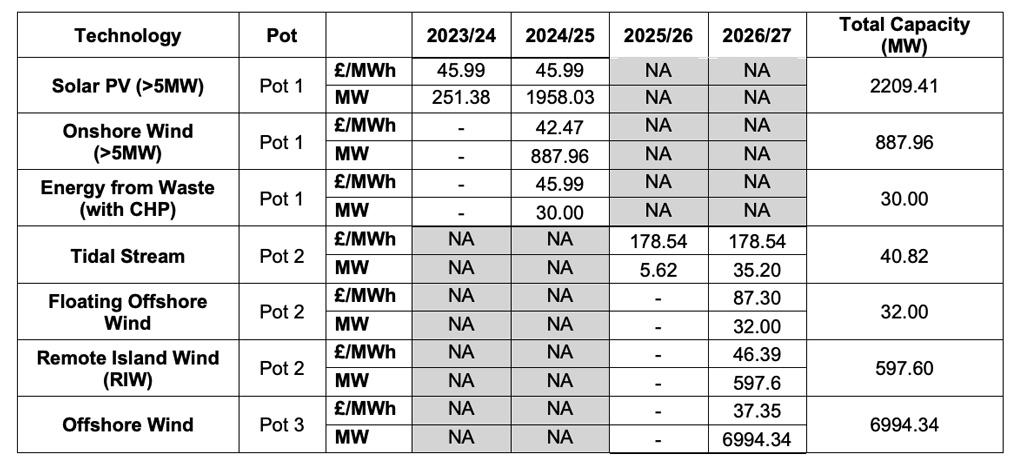
Offshore wind was the cheapest and most significant technology, with 7.0GW of new capacity winning contracts at a record-low price of £37/MWh in 2012 prices (£44/MWh in current money).
Some 2.2GW of new solar capacity also won contracts at an average £46/MWh (£55/MWh today), along with 0.9GW of onshore wind at £42/MWh (£50/MWh today) and another 0.6GW of “remote island wind” at £46/MWh (£55/MWh today).
This auction round was the largest to date by far, securing roughly twice as much capacity as the third round and three times as much as the second, as shown in the chart below. It was also the joint cheapest, with a capacity-weighted average price of £41/MWh in 2012 prices.
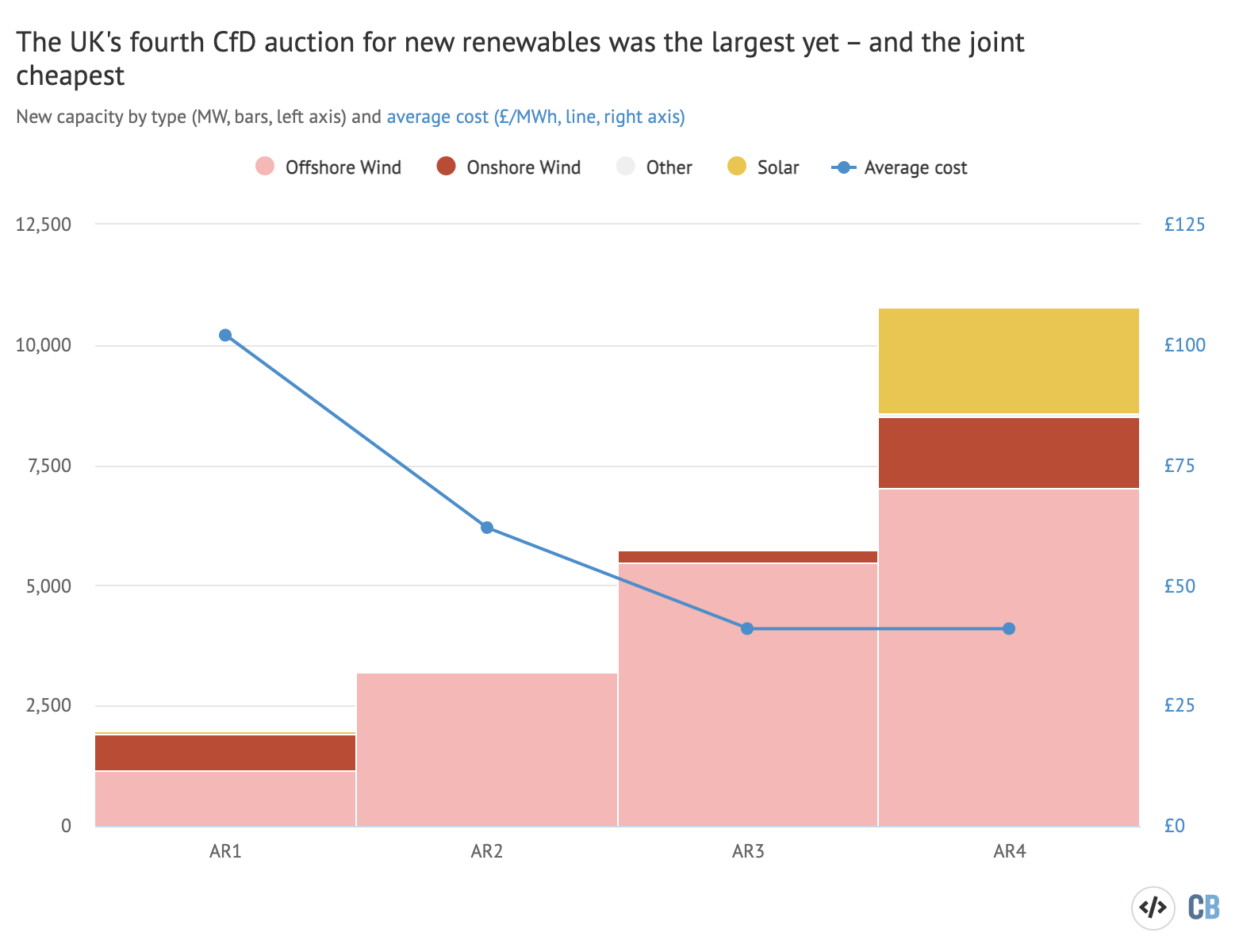
The 10.8GW of capacity in total can be expected to generate around 45TWh of electricity, around 14% of current UK generation and enough to cover the usage of over half or UK homes – or all the additional supply needed to run electric vehicles by the end of the decade.
This 45TWh of new renewable generation, which is due to be up and running in five years, can be compared with the roughly 25TWh of electricity that will be produced by the Hinkley C new nuclear plant in Somerset. Hinkley C has a CfD for £92.50/MWh in 2012 prices (£110/MWh today) and is due to start operating 10 years after its contract was awarded in 2016.
Notably, a 30 megawatt (MW) floating offshore wind project secured a contract in this week’s auction for £87/MWh (£104/MWh). This is well ahead of the cost reduction trajectory for floating offshore wind, under which it was already expected to become “subsidy free by 2030”.
The still-nascent technology is seen as a key to unlocking the potential of the sector because it can be used in deeper water, further from shore, where wind speeds are more consistent. It can also be used in countries, such as Japan, that are surrounded by deep ocean.
Nine times cheaper than gas
The prices secured in this week’s auction are the lowest ever, with the £37/MWh for offshore wind in 2012 prices falling below the previous record of £39.65/MWh.
The prices for onshore wind and solar were also lower than in previous auction rounds.
Moreover, the projects are all around nine times cheaper than the current price of electricity generated in gas-fired power stations, as shown in the chart below.
This price for gas reflects the cost of running existing power plants – buying fuel and permits to emit carbon dioxide – whereas the CfD prices are for building entirely new projects from scratch.
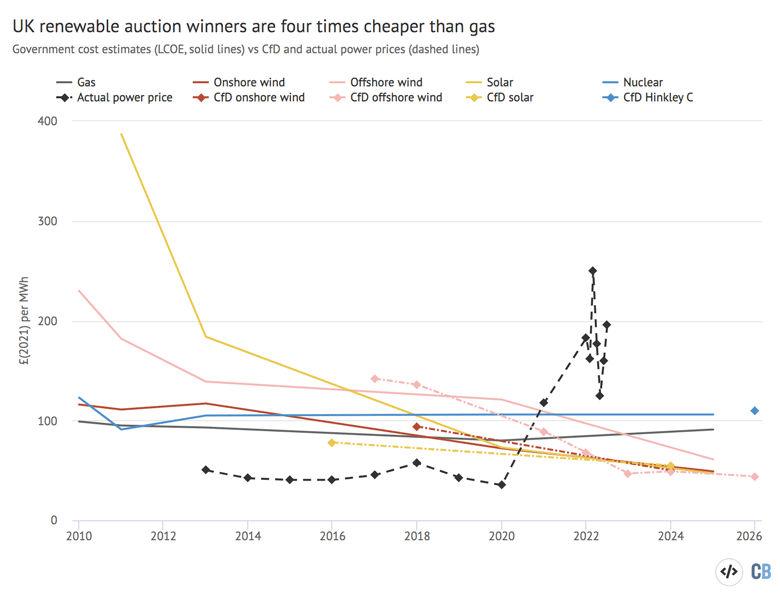
The record-low prices were unexpected as commodity price inflation is thought to have increased the cost of installing wind and solar projects this year. With CfD auctions due to be held annually, there is already speculation about whether there could be higher prices next year.
With strike prices so far below the levels seen in the open market and with high gas prices now expected to persist for years, the projects secured in this week’s auction are due to pay back considerable sums to consumers.
According to Thomas Edwards, modeller at consultancy Cornwall Insight, AR4 projects would pay back £1.5bn a year towards the end of the 2020s, based on their latest price forecasts.
He tells Carbon Brief the projects “will pay back to consumers for much of their lives”.
Similarly, Nathan Bennett, head of public affairs for industry group Renewable UK, tweeted that the schemes would lower average household energy bills by £58 a year.
The Energy and Climate Intelligence Unit, a thinktank, says the projects would save households £100 a year, if the current extremely high market prices persisted. In this scenario, it says savings from current and future CfD projects could reach £500 per household.
The government’s advisory Climate Change Committee (CCC) has estimated that the cost of integrating variable wind and solar into the energy system is around £10/MWh when the generation mix is 50-65% renewable, with the figure rising to £25-30/MWh at 75-90% renewables.
National Grid Electricity System Operator (NGESO), which manages the grid for Great Britain, is working towards being able to operate a stable and secure grid without any fossil fuel power plants for hours at a time by 2025 – and all of the time by 2035.
In addition to the announcement of the CfD auction results, this week also saw the launch of plans for investment of £54bn in upgrading the country’s electricity grid to absorb ever-increasing output from low-carbon technologies, in particular offshore wind.
-
Analysis: Record-low price for UK offshore wind is four times cheaper than gas



